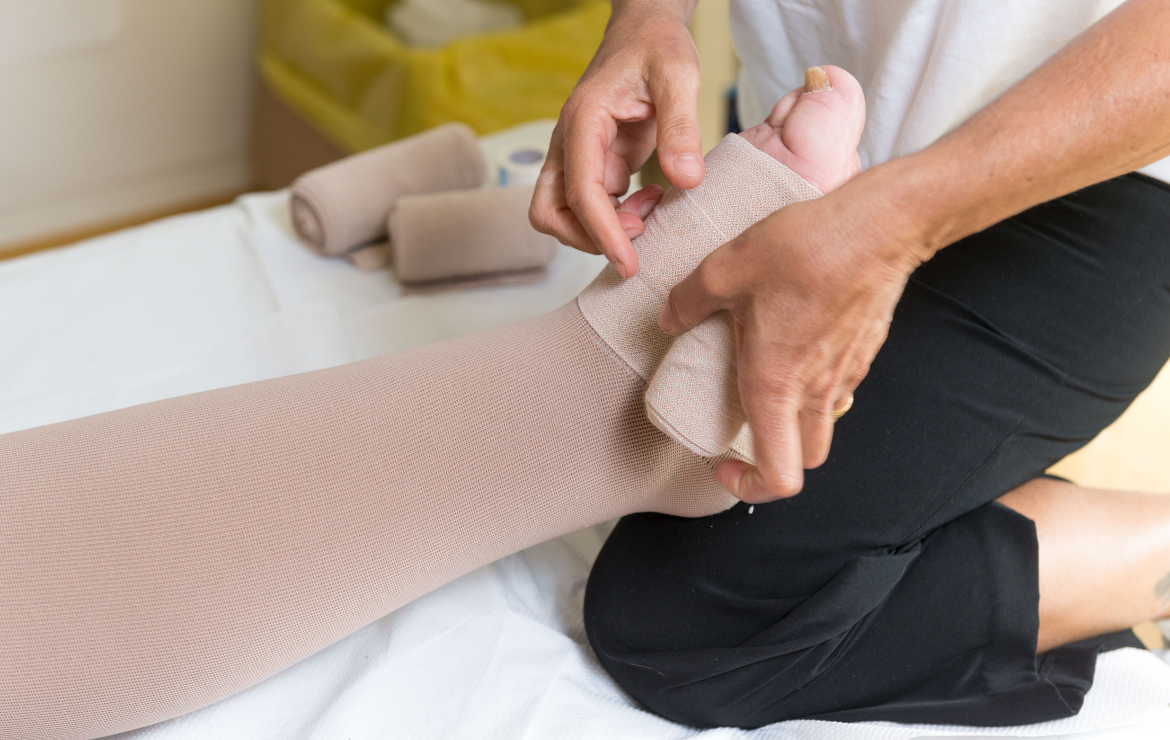For patients living with chronic wounds such as venous ulcers, compression therapy can help to ease symptoms and aid wound healing. This article will outline how compression therapy works as well as the various compression therapy products that can reduce or prevent wound complications such as edema and ischemia.
What is Compression Therapy?
Compression therapy is the use of bandaging or other wound compression products in providing the right amount of pressure to an ulcerous limb or preventing ischemia or necrosis. Compression is the standard treatment for venous ulcers at several stages of the wound healing process. Venous ulcers, also known as stasis ulcers, result from malfunctioning of the venous valves, which causes an increase in intravenous pressure. They appear as chronic sores on the legs that are slow to heal (wound healing over months to several years).
Venous foot ulcers are mostly associated with venous diseases, although they could also result from sedentary lifestyles, obesity, diabetes, arterial disease, and foot trauma. Prominent symptoms of venous ulcers include swelling in parts of or the entire foot and reddish-brown discoloration of the skin (aka stasis dermatitis). Pressure in the limbs of people with venous ulcers during ambulation usually exceeds 40mmHg, which is significantly higher than the normal 22mmHg intravenous pressure in people without the condition. Limited mobility in patients also results in decreased foot and calf pump activity that can exacerbate venous ulcers.
Wound Compression Products
Using wound compression products provides external pressure on ulcerous limbs to prevent venous dilation, improve arterial circulation, reduce inflammation, and ease blood circulation in the lower extremities.
Compression products for managing venous ulcers come in a variety of materials, degree of compression, and sizes. However, they generally fall into compression bandages and stockings worn on the affected limbs.
Compression Bandages
Compression bandages are advanced textiles designed for wound compression. These dressings can help to both treat venous ulcers as well as prevent a re-occurrence. Compression bandages fall into several categories, according to the degree of compression, they provide at the ankles, e.g., light, moderate, high, and extra-high compression. There are three main types; short-stretch (inelastic), long-stretch (elastic), and multilayer compression bandages.
Short-stretch
Short-stretch or inelastic bandages are reusable cotton dressings with high stiffness that provide firm, constant support for the calf muscles during ambulation and low pressure when the patient is at rest. The main advantage of this type of bandage is that it can be laundered and reused. Some products contain zinc or calamine, which prevents itchiness on the wound bed. However, inelastic bandages are minimally absorptive and not suitable for managing wounds with medium to heavy exudate. They may also require frequent replacement due to limb shrinking.
Long-stretch
Long-stretch or elastic bandages can stretch to several times their original length (between 140% to 300%) and conform to any shape with sustained pressure. Like short-stretch bandages, they can be laundered and reused. The main benefit of elastic bandages is that they provide uniform compression at rest and during ambulation. Elastic bandages offer excellent support for edema containment and can relieve pressure on muscles, ligaments, and tendons.
Multilayer Bandages
Multilayer compression bandages consist of two or more layers (typically four layers) of elastic or inelastic material and padding structures. Like long-stretch bandages, these bandages can provide uniform compression over an ulcerated foot in both resting and ambulatory states. Maintaining a compression of between 25-35 mmHg is usually sufficient to reduce swelling in the limbs due to venous ulcers. Multilayer bandages can help to protect bony prominences to prevent wound infections.
Compression Stockings
Compression stockings are of two main types; leg-shaped or flat knitted. The leg-shaped variant can be knee-length or thigh-length. The material of construction is elastic (synthetic) fibers or rubber. Compression stockings are useful for treating venous ulcers of limited sizes, preventing further progression, and sustaining an ideal amount of pressure on the feet after wound healing to prevent a recurrence.
Contraindications in Compression Therapy
Despite numerous benefits for wound management and promoting wound healing, compression therapy is not suitable for wound management in all patients as it can interfere with other treatments such as:
- Congestive heart failure
- Septic phlebitis affecting the lower extremities
- Ischemia
- Immobility due to obesity or paralysis
- Joint disease
- Skin infections
- Loss of sensitivity in the legs
Managing Venous Ulcers in Long-term Care Facilities
The Wound Pros is skilled in managing chronic wounds such as venous ulcers with a dedicated team of wound care experts. Patients at long-term care facilities, such as skilled nursing homes, can benefit from our remote wound management via The Wound Pros telehealth platform.



.webp)

.avif)